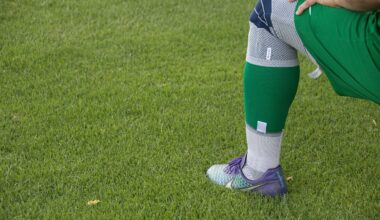Improving Speed and Agility in Guards
Basketball guards require exceptional speed and agility to perform at their best on the court. Enhancing these attributes can involve a variety of training techniques tailored to the unique needs of each player. Effective sprinting drills, footwork exercises, and plyometric routines are some of the most effective ways to maximize performance. Achieving speed is not simply about running faster but also involves learning how to quickly change direction, which is crucial for guards who must navigate through defenders and quickly respond to plays. Agility can be achieved through balance and coordination training. A combination of these skills ensures that guards can maintain control of their body while moving swiftly and executing skillful plays. Additionally, incorporating core strength training can significantly improve overall athletic performance as it provides a strong foundation for explosive movements. Guards can also improve their agility through reaction drills, which focus on quick decision-making and fast movements in response to stimuli. Coaches should emphasize consistency in drills and encourage players to focus on form and technique alongside speed. Overall, a robust program can lead to noticeable improvements in a guard’s style of play.
One effective way to enhance speed is through sprint interval training. This method challenge players to alternate between periods of high-intensity sprints followed by periods of rest or light jogging. Typically, sprint intervals can vary in duration, from 40 to 100 meters. This strategy mimics actual game scenarios, where players often need to sprint at full speed before recovering. Moreover, hill sprints can be an excellent addition to the speed training regimen. Sprinting uphill increases resistance, forcing players to develop strengthened leg muscles, improving their speed on flat surfaces. Incorporate agility ladders into daily drills, focusing on foot speed and foot placement. Agility ladders enhance quick footwork and coordination, both of which are essential for guards. Additionally, cone drills that involve zig-zag running help improve the ability to change directions efficiently. Coaches can implement game-like scenarios during practices to help players adapt their speed to in-game situations that often require quick bursts of energy. Consequently, emphasizing speed in this manner will enhance a guard’s overall gameplay, making them more effective on the court.
Beyond sprinting, plyometric training plays a key role in increasing both speed and agility. This type of training focuses on explosive movements that build power and strength. Common plyometric exercises include box jumps, jump squats, and burpees. These exercises enhance muscular strength, speed, and explosive power, providing guards with additional advantages during games. Regular implementation of plyometric sessions can lead to heightened athletic capabilities within weeks. Furthermore, a key component of plyometric exercises is their emphasis on explosiveness, allowing guards to develop skills necessary for jumping and quick lateral movements. This is essential for evading defenders and positioning oneself for shooting or passing effectively. Coaches may adapt plyometric drills to ensure they simulate the demands of basketball, incorporating specific movements such as jumping and landing. Effective plyometric training should include proper warm-up techniques and cooldown periods to prevent injuries. As players build their energy systems through these intense workouts, they will experience improved fast-twitch muscle responses which translate to faster movements on the court. Ultimately, plyometric training complements speed enhancement for an overall effective training regimen.
Strategy for Balance and Coordination Training
A solid foundation in balance and coordination is crucial to improving speed and agility in guards. Specifically, balance training exercises enable guards to maintain stability while executing swift movements. Activities like single-leg balances, stability ball exercises, and balance beam drills help foster better body awareness. Enhanced balance leads athletes to have better movement control, which is essential for guards navigating through tight spaces during games. Coordination is equally important as it aids in the integration of various skills within the game, such as dribbling while running or making quick passes. To develop coordination, drills that combine agility and speed are particularly effective. Obstacle courses that require fast foot movements and quick decision-making can simulate real-world basketball scenarios effectively. Resistance bands can also provide an excellent way to incorporate coordination drills. Using bands during footwork exercises engages multiple muscle groups, enhancing coordination while developing strength. Consistent practice of these strategies will contribute to overall performance improvement on court. Adopting a holistic approach toward training can strengthen a guard’s capability to react and perform efficiently throughout a game.
In addition to physical training, mental conditioning is vital for enhancing speed and agility in guards. Visualization techniques, for instance, allow players to mentally rehearse movements they intend to execute during games. This improves mental preparedness and can enhance actual performance in real situations. Incorporating reaction time drills that require guards to respond quickly to visual or auditory stimuli can significantly prepare them for game scenarios. Such drills can involve coaches using various signals to prompt players to react and move accordingly. Mental resilience and focus also play a critical role; players should remain composed under pressure, which often directly impacts their ability to move swiftly and accurately. Practicing mindfulness techniques can assist athletes in developing concentration, which can improve performance and decision-making in high-pressure moments. Furthermore, setting practical goals for both speed and agility training sessions can provide a sense of progression and achievement that motivates individual guards. By focusing on both mental and physical attributes, athletes can develop a well-rounded skill set that enhances their playing ability and overall game experience.
Nutrition forms another essential aspect of performance enhancement for basketball guards. Eating a balanced diet rich in carbohydrates, proteins, and healthy fats fuels energy levels, which is vital for all types of training. Proper nutrition positively influences an athlete’s ability to recover and build muscle strength. Guards should focus on consuming a variety of whole foods, including lean proteins, fruits, vegetables, whole grains, and hydrated drinks. Additionally, incorporating snacks prior to practice can equip athletes with sustained energy, while post-workout nutrition aids recovery. Meals that include protein and carbohydrate combinations facilitate faster recovery times and prepare the body for subsequent training sessions. Staying hydrated during practice cannot be overstated; hydration plays a significant role in maintaining energy levels and overall performance. Moreover, deficiencies in certain vitamins and minerals can impact speed and agility, indicating the importance of a well-rounded diet. Athletes should consult with nutrition professionals for personalized diet plans tailored to their specific training needs. Overall, nutrition acts as the foundation upon which an athlete builds speed and agility through training.
Incorporating Rest and Recovery
Finally, the significance of rest and recovery cannot be overlooked in the journey to enhance speed and agility in guards. Engaging in intense training ultimately puts demands on an athlete’s body, leading to fatigue and muscle strain if not managed properly. Scheduled rest days and lighter training periods allow muscles to repair and grow stronger. Furthermore, integrating active recovery days, where light exercises are involved, can promote blood flow and hasten recovery times. Sleep is also a crucial component; adequate rest is necessary for overall health and performance enhancement. Guards should aim for at least seven to eight hours of quality sleep each night to facilitate optimal recovery. Stretching and foam rolling should be incorporated into routine recovery practices, minimizing muscle tightness and soreness after intense workouts. Mindful communication within the coach-player relationship about fatigue levels can inform effective practice scheduling, maximizing performance while preventing overtraining. Consistently adhering to a structured recovery process supports agility and speed growth, ultimately benefiting performance during high-stakes games. Hence, recognizing the value of rest completes the speed and agility training equation.
In conclusion, enhancing speed and agility in guards requires a multifaceted approach combining physical training, mental conditioning, nutrition, and recovery. Implementing various drills and exercises tailored to boost speed, such as sprint intervals and plyometrics, will help players improve their agility on the court. Additionally, incorporating balance and coordination training will fortify their movements during gameplay, while mental preparation will keep athletes focused and resilient under pressure. Diet also plays a vital role; a balanced nutritional plan nourishes the body, fueling performance and recovery. As players dedicate time to enhancing their physical attributes, recognizing rest’s value emphasizes the importance of adequate recovery time between intense training sessions. Coaches should aim to balance training demands with appropriate recovery strategies to ensure players are prepared for competition. By focusing on these aspects, players can see significant improvements in their ability to navigate the court swiftly and efficiently. Basketball guards who commit to a comprehensive training plan are setting themselves up for success, ensuring they have the necessary skills to excel on the court, ultimately contributing to the team’s overall performance.


